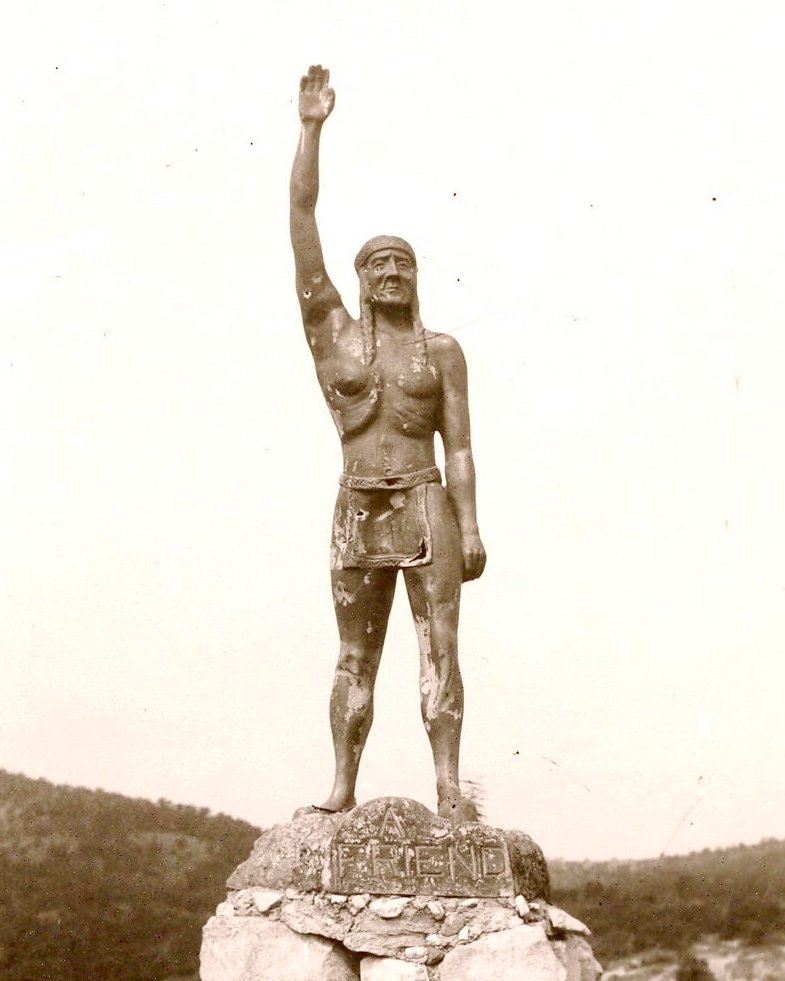TO MY READERS: HOW TO USE THE BLOG
Click Here

Palacine Indian North, courtesy of www.oklahomahistory.net<http://www.oklahomahistory.net>

Palacine Station photo courtesy of Steven Harris, Ardmore, OK--collector of Palacine Indian Memorabilia

Photo of Indian sculpture, courtesy of Cinnamon Carter
In November 2008, sixth-grade reading teacher Cinnamon Carter challenged her students to investigate the history of Native Americans in their small West Texas community of Ballinger. Carter, a relative newcomer to the town, was surprised to learn that many of the students had collected photos and recollections of a long-lost Indian statue that had once graced a local park.
For nearly 20 years, "Chief Palacine" stood on Indian Hill in the Ballinger City Park. Ballinger city official Elmer Shepperd purchased the statue from the Wirt-Franklin Oil and Gas Refinery in Ardmore, Oklahoma, in 1939.
According to Shepperd's nephew, the Ballinger statue was one of two from a Wirt-Franklin gas station at the southeast corner of Main and D Street Southwest in Ardmore. One statue was mounted atop the station and the other stood on a pedestal out front.
According to National Petroleum News (April 24, 1929), the Indian statues were an advertising ploy developed by D. A. Corcoran, head of Wirt-Franklin's sales department. In order to get one of the 11 1/2-foot statues, gas station owners had to carry Wirt-Franklin's Palacine gasoline and oil brands exclusively.
The cast zinc-alloy statues, produced for about $200 each by a Dallas sign company, depicted an Indian chief standing with one hand raised in a gesture of friendship. He stood on a cast metal "rock" over the words "A Friend." The base displayed the words "Palacine - Motor Oil - Gasoline" on three sides.
While no one knows exactly how many statues remain, three have been on display since 1935 at Woolaroc Ranch, former home of Frank Phillips of Phillips Petroleum, in Barnsdall, Oklahoma.
A Wirt-Franklin employee named Eubanks reportedly hauled off 15 statues on Mr. Wirt's orders, around 1952, and buried them in a ditch beside his house on Hedges Road, southwest of Ardmore.
The statue in Ballinger was stolen by vandals sometime in the 1950s. Legend has it that the chief was thrown into the creek below Indian Hill "and never seen again."
Carter's sixth-grade class became fascinated by the Indian and the place that it held in their community's collective memory. Family and wedding photos were often taken with "Friend," and one woman said, "He was the holder of our secrets, because we knew he would never tell a soul."
Carter, who recently established the non-profit Friends of Ballinger Indian Statue to raise money for the project, reports that the City Council, civic groups, and many individuals support the placement of a new Friend statue in the Ballinger Park.
Since January 2009, the students and the "Friends of Friend" have raised $14,000 of the estimated $47,000 needed to commission a bronze replica of Chief Palacine. The statue is being created by local sculptor Hugh Campbell, who specializes in Western art, and it will be cast in bronze by House Bronze, a custom fine art foundry in Lubbock.
Carter and her students continue to hold fundraising events and are beginning to look for grant funding opportunities. For more information, please visit http://www.ballingernews.com/friend.htm
Read what the Class of 2015 has to say about the project at http://www.ballingernews.com/studentletters.htm
If you would like to contribute to the project, please send your tax-deductible gift to Friends of the Ballinger Indian Statue, P. O. Box 231, Ballinger, Texas, 76821.
Steph McDougal
McDoux Preservation
[ view entry ] ( 5429 views ) | permalink |
<<First <Back | 6 | 7 | 8 | 9 | 10 | 11 | 12 | 13 | 14 | 15 | Next> Last>>